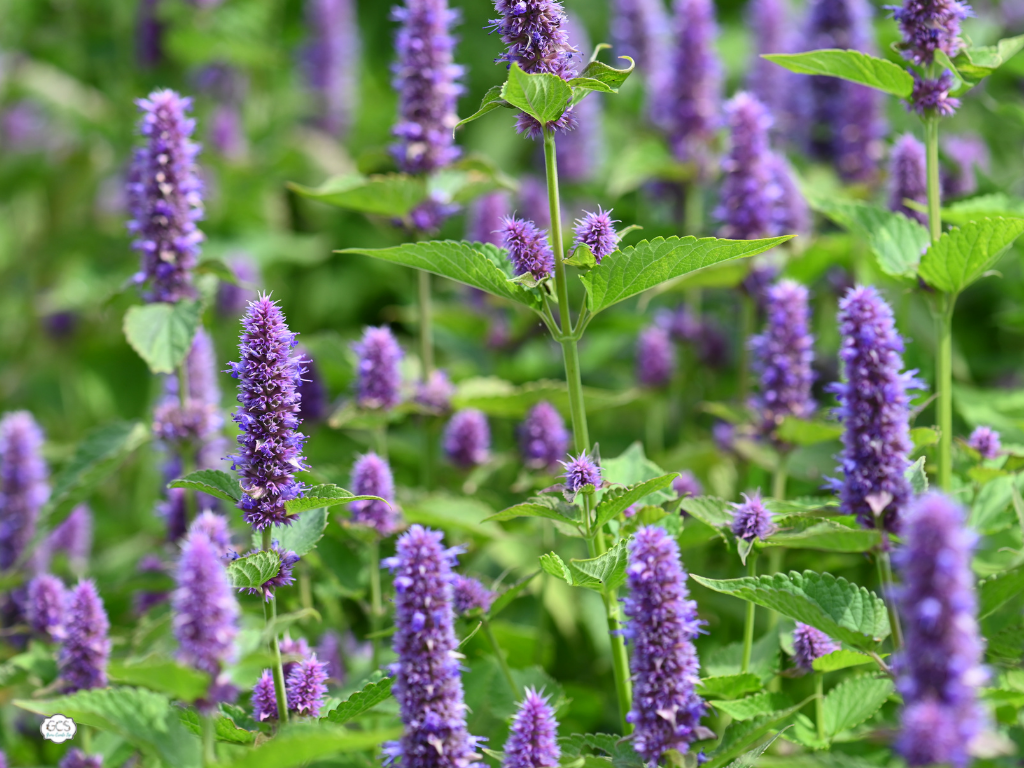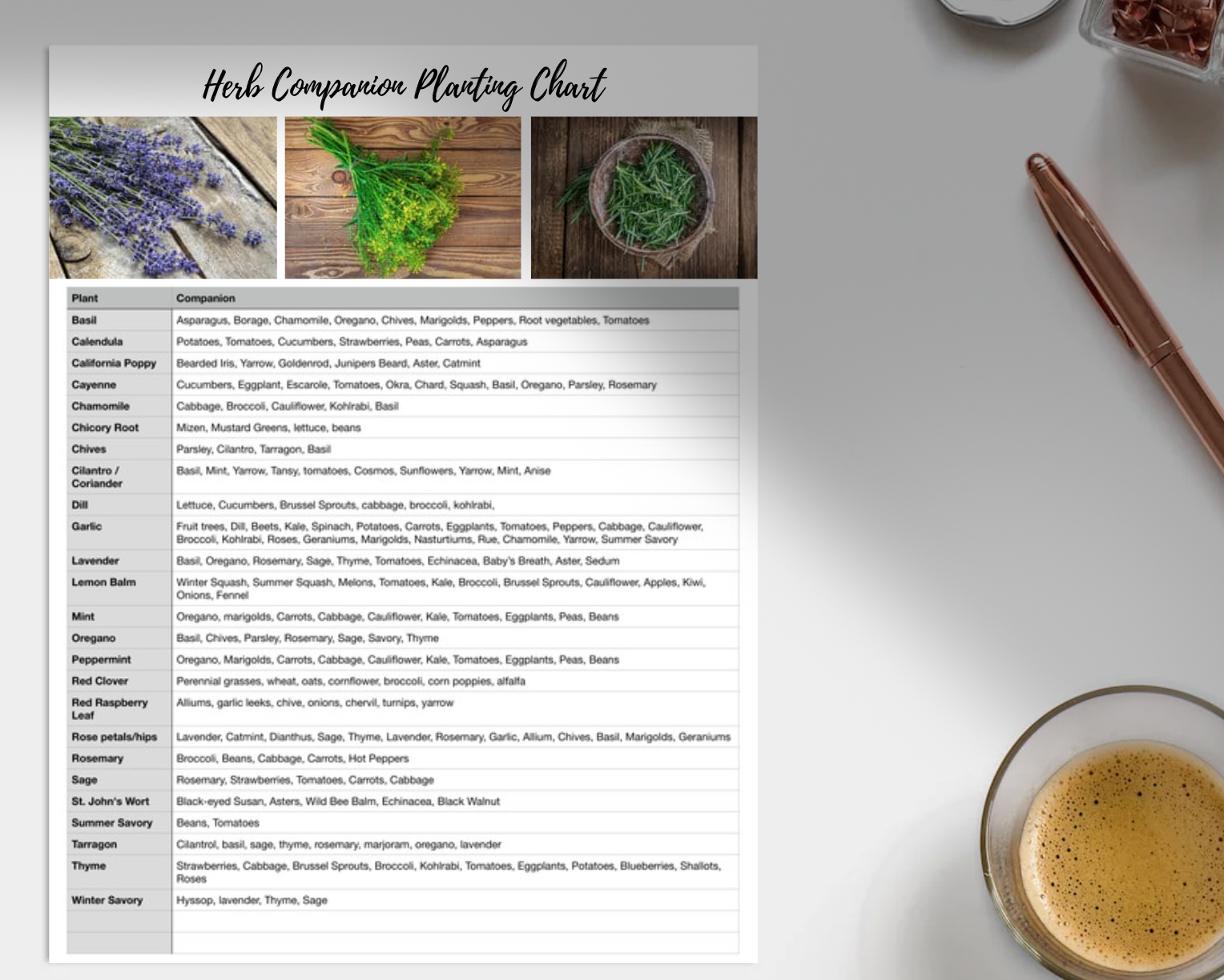Companion Planting Chart for Herbs
May 16, 2022
Did you know that there are more microorganisms in one teaspoon of soil than there are people on the planet? These microbes are an important part of the ecosystem of your garden, and keep your soil healthy and packed full of nutrients.
The thing is, different plants need different things, and an area or patch of soil that works for one herb may not work for the other. This is why working with a companion planting chart is so important.
But what exactly is companion planting? And it sure can feel overwhelming to consider planning and laying out your garden in such a fixed way. Not to worry, we're here with a handy guide for some of the best companion plants (and which ones to avoid), so keep reading to learn a bit more about the fascinating world of plant relationships.

What Is Companion Planting?
Companion planting is a simple and effective way to make sure your plants have the best chance to thrive. Basically, it's when you place two plants together for the benefit of one or both of them. For example, grow nectar-rich flowers around vegetables and fruits to encourage pollination. You could also use one plant as an insect repellent or to discourage caterpillars or aphids. It's as simple as that!
A lot of the research around companion planting focuses on vegetable gardens, but there is plenty of evidence to support the benefits of companion plants for both culinary and medicinal herbs. However, unlike other areas of gardening, which try to balance soil pH and nutrients, companion planting is based on observation and passed down knowledge.
There will always be a level of trial and error to see what works best for you and your garden. Everyone needs to just understand that a garden is simply a biodiverse system of plants that are all connected and reliant on one another. Having this understanding will help you make better plant choices!
Why a Companion Planting Chart Works
Companion planting has several advantages, and we've already touched on some, like pollination and insect repellents. Some plants also make it challenging or unsavory for predators or unwanted creatures to make their homes in your garden. For example, cucumbers are apparently unappealing to raccoons.
Some plants can also help improve soil fertility through better nutrient delivery and uptake. In terms of vegetables, tall plants like corn can provide shade for crops that don't do so well in the sun, like lettuce and support the growth of trellising plants. Following a companion planting guide can even help keep weeds at bay.

Things to Avoid
In the same way that plants have helpful neighbors, there will be plenty of plants that are less helpful, and potentially even detrimental. Plants that compete for fertilizer and nutrients have differing water needs, or different root systems (above or below ground systems) shouldn't be planted next to each other. In the same way, plants that have very different light needs won't thrive together.
Crops vulnerable to the same diseases, like tomatoes and plant blight, should be kept as far apart as possible to prevent the disease from running rampant. You want to apply the same principles to plants that attract certain pests, though there are exceptions to this. Some plants can also physically stifle the growth of others.
Fennel is a good example of this. It's often the prime example of a "bad neighbor" plant and should be kept separate from other herbs.

Herbs That Work Together
Before considering planting herbs together, remember that some may need to be rotated to avoid pest and disease problems. Where this isn't possible, like in small gardens, you may not need to worry too much about it. As long as you're keeping your garden clean and healthy, and replenishing the soil as necessary, you shouldn't have any nutrient or pest problems.
Our primary focus for today is to look at what herbs we can plant together that is going to benefit one another, and aim to create a space that is nourishing and healthy for your plants. Let's look at some of the more popular options.

Parsley
Parsley pairs particularly well with vegetables like tomatoes, chives, peppers, and peas. With that in mind, lettuce and mint don't make good neighbors for parsley companion plants, and you should keep them both far away. Perhaps the most surprising companion plant for parsley is the rosebush. Parsley flowers attract hoverflies, which eat aphids and other insects.

Dill
Young dill plants act as pollinators and discourage a plethora of unwanted pests while encouraging ladybugs, butterflies, and honeybees. They make fit companions for chives, lemon balm, lovage, and lemon balm. Some poor dill companion plants to avoid are cilantro and lavender, as well as peppers, potatoes, and carrots (dill and carrots can easily cross-pollinate, which isn't ideal.)

Basil
Basil is great planted next to tomatoes, and is it any wonder, considering how well they go together in the kitchen? It also grows well with oregano, cilantro, and parsley, as they have similar nutrient and soil requirements. Aside from those three other herbs, however, basil companion plants tend to be more vegetable and fruit-based, rather than other herbs.

Cilantro
Cilantro companion plants are easy to come by and you can plant them near tomatoes or spinach, or planted in rows as borders for fruits and vegetables. Basil, mint, tansy, and yarrow are all good options, but it's best to avoid planting cilantro near lavender, thyme, rosemary, and fennel.
Fun fact, making tea from cilantro and spraying it onto plants is a great way to get rid of spider mites.

Lavender
Lavender is one of those great plants for the home or garden, as it not only looks and smells gorgeous but is great for bees and making all sorts of home remedies. Hint: it also tastes great with food and desserts. Some of the best lavender companion plants are echinacea, roses, yarrow, alliums, rosemary, thyme, sage, and oregano.
You want to avoid growing lavender with mint, particularly, and flowers like impatiens and camellias.

Mint
Mint is another great all-rounder, and it does great with plants like tomatoes and peas, as it works as a deterrent for flea beetles and aphids. It grows well with oregano and marigolds, but not with parsley. As it can be quite an aggressive plant, it's best to plant it near other hardy growers.
Note: Mint is a voracious spreader, so it's best to grow it in its own pot or bed, or near a companion plant that can tolerate its disregard for personal space.

Sage
Because sage grows into a bush, it's a great companion plant for other hardy growers like rosemary. Though it also pairs well with parsley, as it isn't as invasive as rosemary. In terms of fruits and veggies, sage grows well with strawberries and tomatoes, as it can actually enhance their flavor. It's best to avoid growing sage near alliums, wormwood, and fennel.

Calendula
Calendula draws pollinators to the garden, such as bees and butterflies, which are necessary for plant reproduction, so it's great near vegetables and fruits. It's also a member of the marigold family, which has a reputation for keeping pests away. Therefore, you want to plant calendula near fruits and veggies, though it does well with mint and sage too.

Rosemary
Herbs that have similar growing needs to rosemary are sage, thyme, lavender, oregano, and marjoram, which means they will all grow well together. You can also plant parsley and chives near rosemary because, while they rarely like the same growing conditions, they get along well. Rosemary is a natural anti-pest plant, so will offer excellent protection for these more delicate herbs.

Anise
It's unwise to grow basil, carrots, or rue near anise, but cilantro is a safe choice. Because cilantro and anise promote germination and growth together, they're great companion plants. You can also plant it near cabbage, beans, and even grapes!

Understanding How to Pair Plants
Although companion planting has a long history, the techniques for growing plants for mutual benefit are not necessarily clearly documented in texts. Oral tradition, front porch musings, and family suggestions are mostly what we have to work with. Although it isn't always an exact science, it's a great way to plan and approach a garden space.
Companion planting can help maximize the yield of herbs, vegetables, and fruit, and helps prevent insects and pests while maintaining healthier soil. You'll eventually notice that when grown properly, food and herbs even taste better when planted near the right friend. But, that being said, the lack of widespread information can be challenging.
Here are a few key reminders to help you get started with your next gardening adventure:
- Don't plant tall plants near ones that need full sun
- Use pest controllers near sensitive herbs
- Avoid monocultures (or the same plant grown in mass)
- Avoid fast-growing plants in large, open spaces
- Plant loads of pollinators near vegetables
- Remember, it's okay to experiment
At the end of the day, everyone's garden is going to be different, and produce different yields. What works for one person may not work for you, but there are a few tried-and-true rules you can at least start out with. Enjoy the process and make solid notes as you go. You never know, your notes may be what helps your children (and their children) design a flourishing garden space.
Keep Your Resources Close
So now that we understand what goes together (and what doesn't), do you feel more confident about putting together a well-thought-out space, with plants that thrive together? It's not so hard, after all, it just takes a little planning and maintenance, but aside from that, the possibilities are full of potential! Just make sure you work with a thorough companion planting chart, and you'll be good to go! I'd highly recommend printing it and then having it laminated so that you can take it along with you to the garden. Download your free companion planting herb chart here.
If this all seems a bit overwhelming to you and you would love to hear stories of practical applications from real live herb gardeners just like you make sure that you check out our Herbal Studio Communi-tea! It's. a great place similar to Facebook minus any algorithm so you don't miss a single post. Experts to beginning herb gardeners are in there now chit-chatting about all things herb gardens! We would love to have you.
In the meantime, I"d love to know have you ever done any companion planting or are you new to the idea? Share your experiences down below in the comment section.
Other Herb Growing Posts
- How to Stratisfy and Scarify Herb Seeds
- Herbalist Garden: Getting Started
- How to Plant and Propagate Elderberry Bushes
- How to Grow Roses from Cuttings (Edible Roses)
- Growing Herbs in Pots
- How to Harvest Herbs Efficiently (Top 5 Harvest Tools)















